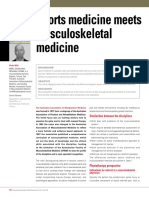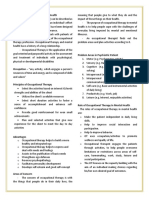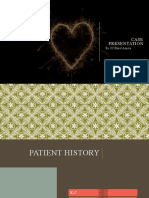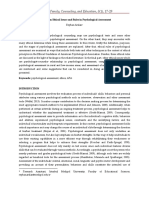Balunan, Mikaella C. Obcl 2 BSN 4Y2-1
Balunan, Mikaella C. Obcl 2 BSN 4Y2-1
Uploaded by
MIKAELLA BALUNANCopyright:
Available Formats
Balunan, Mikaella C. Obcl 2 BSN 4Y2-1
Balunan, Mikaella C. Obcl 2 BSN 4Y2-1
Uploaded by
MIKAELLA BALUNANOriginal Title
Copyright
Available Formats
Share this document
Did you find this document useful?
Is this content inappropriate?
Copyright:
Available Formats
Balunan, Mikaella C. Obcl 2 BSN 4Y2-1
Balunan, Mikaella C. Obcl 2 BSN 4Y2-1
Uploaded by
MIKAELLA BALUNANCopyright:
Available Formats
BALUNAN, MIKAELLA C.
OBCL 2 BSN 4Y2-1
CASE STUDY:
Minda is a 65-year-old female who works as a cutter and dressmaker in a local shop near a university
which sews blazers and uniforms. She has sought consultation in the clinic where you work as a nurse.
She presents with recurrent pain and stiffness in both hands every time she wakes up in the morning
which lasts for about 20 minutes. It happens too, she said, whenever she takes longer periods to rest her
hands from her daily routine in the shop. She wanted to ask too for advice regarding. Ibuprofen or
Glucosamine with Chondroitin to help with what she perceives as “arthritis pain” in both
her hands. She learned about these treatments from a co-worker in the shop. She says she is afraid that
the arthritis “has spread” to her other joints as she is already starting to feel some pains on her right
knee joint too. Her record says she has a BMI of 31 kg/m2, has hypertension and type 2 diabetes
mellitus. Initial examination of both of her hands shows no deformities and no visible signs of
inflammation. When asked, Minda states she is looking for pain relief and fears the arthritis “will
spread” to her other joints as well and eventually render her incapable of work.
Question 1: As gathered from the data, what four risk factors for OA does Minda have? Why do you say
so? (20 points)
Age- Higher age through oxidative damage, thinning of cartilage, muscle weakening, reduces
the basic cellular mechanism that maintain tissue homeostasis which leads to an insufficient
response to stress or joint injury.
Gender- the frequency of osteoarthritis in women and men are 68% and 58% respectively,
women have a higher greater level of pain and disability
Obesity- extra weight can push down on joints causes pain and inflammation, which can make
everyday movement challenging.
Occupation- facing heavy loads and having stress activities such as workers whose job require
repeated and prolonged sitting are consequently associated hip and hand OA, respectively.
Question 2 Identify at least 4 learning needs that Minda must be given information about?:
Disease modification
Diagnosis and management
Patient knowledge
Perceived health information needs
What sort of information should be given to her in relation to these needs? (20 points)
Optimal management of osteoarthritis requires active patient participation. Understanding
perceived heath information needs is important to optimize health service delivery and
outcome in osteoarthritis.
BALUNAN, MIKAELLA C.
OBCL 2 BSN 4Y2-1
Health assessment information regarding the diagnosis of osteoarthritis, its impact on daily life
and its logical management options, but also non-pharmacologic option to help them manage
the symptoms. Also, patient wanted this information to be delivered in a clear manner from
multiple sources of health information.
Question 3. Which of the following drug poses the least risk for Minda? Give the rationale for your
answer. Also give the rationale for not choosing the other three (20 points).
Nonsteroidal anti-inflammatory drugs (NSAIDs) treat pain. They also help to prevent painful
inflammation and joint damage. They're the top choice of treatment for OA because they're effective
and nonsedating. NSAIDs come in oral and topical forms.
Used to treat minor aches and pains of the muscles/joint, works by decreasing a certain natural
substance in body that help pass pain signals to the brain.
This product may contain inactive ingredients, which can cause allergic reactions or other
problems.
Used to treat fever and mild to moderate pain.
Is not an effective choice for relieving osteoarthritis pain in the hip or knee, or for improving
joint function.
Has been shown to help with osteoarthritis who have mild to moderate pain.
Question 4 (40 points)
Minda also claims of feeling pain and stiffness on her right knee which gives her the feeling that her”
arthritis has spread”. In your mind, you start to evaluate in which of the 4 stages of knee OA her case
belongs to.
• Make a table and fill in with the following descriptions:
Column 1 FOUR STAGES OF OSTEOARTHITIS OF THE KNEE
Column 2 DESCRIPTION of EACH STAGE
Column 3 TREATMENT for EACH STAGE
Column 4 NURSING INTERVENTION
STAGES OF OA DESCRIPTION TREATMENT NURSING
INTERVENTION
During stage 1 is not
DOUBTFUL The joint begins to invasive and focuses on Lifestyle
narrow, cartilage lifestyle changes, consideration
starting to breakdown supplements, and over- like regular
and the body starts to the-counter exercise may
create osteophytes medications. also prove to
be helpful.
BALUNAN, MIKAELLA C.
OBCL 2 BSN 4Y2-1
(bone building blocks Weight loss is
an important
approach to
pain and
disability
improvemen
Taking pain relievers
MILD known as the mild attending physical Exercise- losing
stage on OA. X-rays therapy sessions to weight through
shows a lot of bone build or maintain diet and
spur growth in the strength and flexibility. exercise can
joint, but the cartilage help relive
is still healthy with no minor
sign of damage. symptoms and
Synovial fluid is still improve quality
present at sufficient of life.
levels for normal joint
movement low-impact
aerobics and
strength
training can
help
strengthening
the muscle
around the
joint
MODERATE known as moderate known as moderate Monitor the
osteoarthritis. Cartilage osteoarthritis. Cartilage level of
between bones show between bones show inflammation/
obvious damage and obvious damage and pain the joint
the space between the the space between the
bones begins to bones begins to narrow Help client to a
narrow. warm
compress.
Exercise such
as walking
should
moderately
and increase
gradually
Severe OA of the knee,
SEVERE joint space is signific an option id Assistive devices. Canes
ally narrowed with the performing osteotomy and other ambulatory
bones touching each or bone realignment devices care extremely
other. The friction
BALUNAN, MIKAELLA C.
OBCL 2 BSN 4Y2-1
surgery, wherein the
caused by the bones orthopedic surgeon helpful for ambulation
rubbing against each cuts the bone above
other significantly the knee to shorten the
causes inflammation length and help realign
it for less stress on the
knee joint.
You might also like
- Assisted Stretching 1Document7 pagesAssisted Stretching 1Kostas Ghinis100% (1)
- Assessment Nursing Diagnosis Planning Implementation Scientific Rationale EvaluationDocument5 pagesAssessment Nursing Diagnosis Planning Implementation Scientific Rationale Evaluationjennelyn losanta100% (2)
- Abused and Forgotten: Life Inside The BVCF Protective Custody HallwayDocument44 pagesAbused and Forgotten: Life Inside The BVCF Protective Custody HallwayMichael_Roberts2019No ratings yet
- Appendix E - Monthly Meeting, Kick Off and HSE WorkshopDocument2 pagesAppendix E - Monthly Meeting, Kick Off and HSE WorkshopNaba majeadNo ratings yet
- Musculoskeletal PainDocument2 pagesMusculoskeletal Painmercedes bonillaNo ratings yet
- The Effectiveness of Soft Tissue Release For Healing Lower Limb InjuryDocument3 pagesThe Effectiveness of Soft Tissue Release For Healing Lower Limb InjuryVũ Đức ChínhNo ratings yet
- Problem List 1. Acute Pain 2. Nutrition Less Than Body Requirements 3. Impaired Physical Mobility 4. Impaired Skin Integrity 5. Disturbed Body ImageDocument12 pagesProblem List 1. Acute Pain 2. Nutrition Less Than Body Requirements 3. Impaired Physical Mobility 4. Impaired Skin Integrity 5. Disturbed Body Imagebernadette babaranNo ratings yet
- To Study The Effects of Muscle Energy Technique With Conventional Treatment Along With Cellular Nutrition in Patients With Knee OsteoarthritisDocument5 pagesTo Study The Effects of Muscle Energy Technique With Conventional Treatment Along With Cellular Nutrition in Patients With Knee OsteoarthritisZickey MaryaNo ratings yet
- Exercise For Older AdultsDocument8 pagesExercise For Older AdultsTengku EltrikanawatiNo ratings yet
- Interaction Between Pain, Movement, and Physical ActivityDocument11 pagesInteraction Between Pain, Movement, and Physical ActivityNICOLÁS ANDRÉS AYELEF PARRAGUEZNo ratings yet
- Pe ReviewerDocument8 pagesPe Reviewer2023201040No ratings yet
- Obesity Pain and Exercise SolutionsDocument15 pagesObesity Pain and Exercise SolutionsIulia ElenaNo ratings yet
- 907 FullDocument6 pages907 FullItai IzhakNo ratings yet
- Grade 10 Power PointDocument37 pagesGrade 10 Power PointMarc Jacob MolionNo ratings yet
- Low Back Pain EbookDocument8 pagesLow Back Pain Ebookjanakikumari993No ratings yet
- 907 FullDocument6 pages907 FullMilton Ricardo de Medeiros FernandesNo ratings yet
- Info On AyurvedaDocument1 pageInfo On AyurvedaPriyank JivaniNo ratings yet
- Movement Health JBMT 2015Document10 pagesMovement Health JBMT 2015celal yamanNo ratings yet
- Managing Low Back Pain: Exercise, Manual Therapy, and EducationDocument1 pageManaging Low Back Pain: Exercise, Manual Therapy, and Educationgraciela rosario guija rodriguezNo ratings yet
- A Comparative Study of Standing Balanceperformance Between Oa Knee Patients Compared With Normal Age Matched ControlsDocument11 pagesA Comparative Study of Standing Balanceperformance Between Oa Knee Patients Compared With Normal Age Matched ControlsDr. Krishna N. SharmaNo ratings yet
- managing back pain in daily practiceDocument35 pagesmanaging back pain in daily practiceArintia AubreyNo ratings yet
- NCP 2024Document10 pagesNCP 2024francis ian AnchetaNo ratings yet
- 2582 12335 1 PBDocument8 pages2582 12335 1 PBAndi YulianaNo ratings yet
- 356-Article Text-1309-1-10-20180924Document10 pages356-Article Text-1309-1-10-20180924wildan yogaNo ratings yet
- Musculoskeletal Pain and Exercise-Challenging Existing Paradigms and Introducing NewDocument6 pagesMusculoskeletal Pain and Exercise-Challenging Existing Paradigms and Introducing NewCelia CaballeroNo ratings yet
- Avn CaseDocument7 pagesAvn CaseTaanisha SharmaNo ratings yet
- Jurnal William Flexion Exercise PDFDocument13 pagesJurnal William Flexion Exercise PDFRennyRay67% (3)
- Effectiveness of Stretching Exercise On Joint Pain Among Obese Women in Waghodia VillageDocument32 pagesEffectiveness of Stretching Exercise On Joint Pain Among Obese Women in Waghodia VillageJalak PatelNo ratings yet
- NCP-dom (3)Document3 pagesNCP-dom (3)Ivanah Mae AcloNo ratings yet
- Sports Medicine Meets Musculoskeletal MeDocument3 pagesSports Medicine Meets Musculoskeletal MeMotea IoanaNo ratings yet
- Effects of Gluteal Muscle Strengthening Exercise-BDocument13 pagesEffects of Gluteal Muscle Strengthening Exercise-BZainab Noor ShahidNo ratings yet
- Major ProjectDocument10 pagesMajor Projectbharath rajNo ratings yet
- NCP OsteoporosisDocument5 pagesNCP OsteoporosisAnonymous gAwcPNVRNo ratings yet
- OSTEOARTHRITISDocument5 pagesOSTEOARTHRITISMauren DazaNo ratings yet
- Pathfit 1Document6 pagesPathfit 1gabosara298No ratings yet
- Careplan 1Document1 pageCareplan 1fenavel475No ratings yet
- CP 94d - Information Sheet 4 - Acute Shoulder PainDocument2 pagesCP 94d - Information Sheet 4 - Acute Shoulder PainJanetNo ratings yet
- Spondylosis 32Document3 pagesSpondylosis 32anaab atif ahmedNo ratings yet
- Exercise 2018Document10 pagesExercise 2018robssNo ratings yet
- Referat - FisioterapiDocument28 pagesReferat - FisioterapiBella Faradiska YuandaNo ratings yet
- Groin Pain in Football Players: A Systematic Diagnostic ApproachDocument5 pagesGroin Pain in Football Players: A Systematic Diagnostic ApproachCherbiti Mohammed Amine100% (1)
- Muscle Testing: Professional SchoolsDocument3 pagesMuscle Testing: Professional SchoolsRV's Banana RotiNo ratings yet
- Knee Therapeutic Exercise For Musculoskeletal InjuriesDocument72 pagesKnee Therapeutic Exercise For Musculoskeletal Injuriesسلمه سآميNo ratings yet
- Nursing Care For Ederly in Osteoarthritis Case With Cronic Pain ProblemDocument13 pagesNursing Care For Ederly in Osteoarthritis Case With Cronic Pain ProblemMitha Amelia PutriNo ratings yet
- Chronic: Low Back PainDocument2 pagesChronic: Low Back PainMuhd ArifNo ratings yet
- Pi Is 1836955316300911Document6 pagesPi Is 1836955316300911Fhy NiieNo ratings yet
- Physiotherapy Management of Fibromyalgia 2000Document8 pagesPhysiotherapy Management of Fibromyalgia 2000PranjalNo ratings yet
- Back Pain Relief PDFDocument3 pagesBack Pain Relief PDFStephen MooreNo ratings yet
- PreparationDocument8 pagesPreparationEllias RoseNo ratings yet
- Effektifitas Combination of Isotonic For LowbackpainDocument7 pagesEffektifitas Combination of Isotonic For LowbackpainBoss BacolNo ratings yet
- Brochure Stretching For People With MS An Illustrated ManualDocument32 pagesBrochure Stretching For People With MS An Illustrated ManualAnonymous Ak60ysM7qENo ratings yet
- Manual - of - Orthopaedics - (PG - 13 230)Document218 pagesManual - of - Orthopaedics - (PG - 13 230)2wk8cr7rmdNo ratings yet
- NCP Case StudyDocument21 pagesNCP Case StudyMontero, Ma. Cecilia - BSN 3-BNo ratings yet
- 597 FullDocument7 pages597 Fulldavidjuvinao4No ratings yet
- Osteoarthritis Fact SheetDocument1 pageOsteoarthritis Fact SheetAlief AkbarNo ratings yet
- NCP PainDocument2 pagesNCP PainKyle Margaret FloresNo ratings yet
- Joint Mobilization EnhancesDocument12 pagesJoint Mobilization EnhancesDavid BrunoNo ratings yet
- I Wayan Widhi AdnyanaDocument12 pagesI Wayan Widhi AdnyanaRafis Eko SetiawanNo ratings yet
- a-comparative-study-to-see-effectiveness-of-mckenzie-exercises-versus-wiifit-yoga-on-paDocument7 pagesa-comparative-study-to-see-effectiveness-of-mckenzie-exercises-versus-wiifit-yoga-on-pakhadijahNo ratings yet
- BrochureDocument6 pagesBrochureFleet Calixto VII TrillanesNo ratings yet
- Case Study:Plaque Psoriasis: Balunan, Mikaella C. BSN 4Y2-1 Inp Course Task 11Document4 pagesCase Study:Plaque Psoriasis: Balunan, Mikaella C. BSN 4Y2-1 Inp Course Task 11MIKAELLA BALUNANNo ratings yet
- Mr. P Infectious Disease o Patient Developed Diarrhea 2 o Diagnosed With Chronic Medical ManagementDocument2 pagesMr. P Infectious Disease o Patient Developed Diarrhea 2 o Diagnosed With Chronic Medical ManagementMIKAELLA BALUNANNo ratings yet
- Balunan, Mikaella C. BSN 4Y2-1 Inp Course Task 10Document3 pagesBalunan, Mikaella C. BSN 4Y2-1 Inp Course Task 10MIKAELLA BALUNANNo ratings yet
- Basic Medical Education AccreditorsDocument10 pagesBasic Medical Education AccreditorsMIKAELLA BALUNANNo ratings yet
- Newborn Screening in The PhilippinesDocument10 pagesNewborn Screening in The PhilippinesMIKAELLA BALUNANNo ratings yet
- Family Health NursingDocument17 pagesFamily Health NursingMIKAELLA BALUNANNo ratings yet
- CommunicationDocument13 pagesCommunicationMIKAELLA BALUNANNo ratings yet
- Rle AssDocument5 pagesRle AssMikaCasimiroBalunanNo ratings yet
- NCP PSGN Acute Flank PainDocument1 pageNCP PSGN Acute Flank PainMIKAELLA BALUNANNo ratings yet
- 146-Article Text-477-1-10-20230731Document11 pages146-Article Text-477-1-10-20230731merlynsinaga89No ratings yet
- Isuog BasisDocument40 pagesIsuog BasisAndreea IonașcuNo ratings yet
- Case Presentation On Supraventricular TachycardiaDocument64 pagesCase Presentation On Supraventricular TachycardiaHazel AsperaNo ratings yet
- Covid-19 and Attitudes of Ground-Level Public Health Staff in Sri LankaDocument6 pagesCovid-19 and Attitudes of Ground-Level Public Health Staff in Sri LankaIJAR JOURNALNo ratings yet
- Ob Report On MobilinkDocument36 pagesOb Report On Mobilinkmuhammad irfan100% (2)
- Ntruhs Thesis Topics in DermatologyDocument6 pagesNtruhs Thesis Topics in Dermatologygbxm8h7g100% (2)
- MD-U1000 Series User's Manual: 3-Axis UV Laser MarkerDocument46 pagesMD-U1000 Series User's Manual: 3-Axis UV Laser MarkerJorge HuertaNo ratings yet
- DocumentDocument3 pagesDocumentDavidNo ratings yet
- CS149 Module 10Document5 pagesCS149 Module 10software 111No ratings yet
- Auditory Brainstem Response (ABR) Testing: How Is The Test Done?Document3 pagesAuditory Brainstem Response (ABR) Testing: How Is The Test Done?John Paul PrestonNo ratings yet
- Research Essay Final DraftDocument13 pagesResearch Essay Final Draftapi-609568981No ratings yet
- Bharat India: Data AnalysisDocument209 pagesBharat India: Data AnalysisP Eng Suraj SinghNo ratings yet
- Safety Manual: Risk Ranking MatrixDocument3 pagesSafety Manual: Risk Ranking MatrixMohammed Zubair100% (1)
- KERNICTERUSDocument12 pagesKERNICTERUSSandy GraceNo ratings yet
- Field Study 1.5: Creating An Appropriate Learning EnvironmentDocument10 pagesField Study 1.5: Creating An Appropriate Learning EnvironmentAngelu Dalida SanchezNo ratings yet
- Mark The Letter A, B, C, or D On Your Answer Sheet To Indicate The Sentence That Best Completes Each of The Following ExchangesDocument4 pagesMark The Letter A, B, C, or D On Your Answer Sheet To Indicate The Sentence That Best Completes Each of The Following ExchangesSo Cute So CuteNo ratings yet
- Consumer Behavior Towards Over-The-Counter Medicine Purchase: The Extended Theory of Planned BehaviourDocument9 pagesConsumer Behavior Towards Over-The-Counter Medicine Purchase: The Extended Theory of Planned Behavioursairaam TechNo ratings yet
- FHEL1114 ELP 202205 - WEEK 1 - Listening Lecture PowerPoint SlidesDocument38 pagesFHEL1114 ELP 202205 - WEEK 1 - Listening Lecture PowerPoint SlidesXin Ya FongNo ratings yet
- Level of Stress ASPALALS GROUP Edited VerDocument67 pagesLevel of Stress ASPALALS GROUP Edited VerStephany PolinarNo ratings yet
- ENGLISHDocument6 pagesENGLISHamar137928No ratings yet
- Arslan (2009)Document13 pagesArslan (2009)SITI ZURAIDAH BINTI MOHAMEDNo ratings yet
- Register Kunjungan Pasien BPJSDocument7 pagesRegister Kunjungan Pasien BPJSLuLu Ika RizkikaNo ratings yet
- Linden Community PlanDocument112 pagesLinden Community PlanNeighborhood Design CenterNo ratings yet
- Week 9 6th-8thDocument14 pagesWeek 9 6th-8thapi-505988878No ratings yet
- Msds 3m ResinDocument26 pagesMsds 3m ResinHeri SetiawanNo ratings yet
- Angela DC. Revereza BPED2: 1. Was The Parent's Decision Correct?Document2 pagesAngela DC. Revereza BPED2: 1. Was The Parent's Decision Correct?Angela ReverezaNo ratings yet
- Code of Practice 4 Sauna and Steam RoomsDocument4 pagesCode of Practice 4 Sauna and Steam RoomsВасилий Теут100% (1)
- Merseyside Risk Assessment V2Document5 pagesMerseyside Risk Assessment V2rob_gorstNo ratings yet


































































































